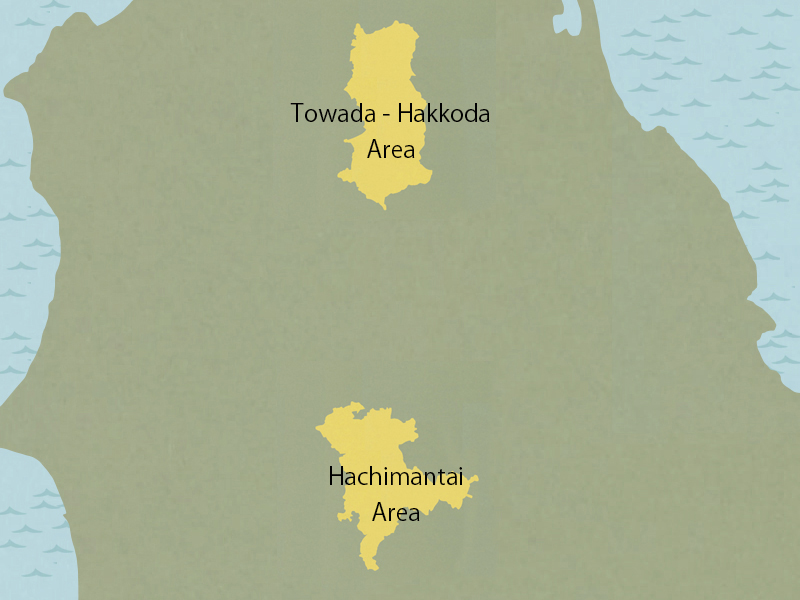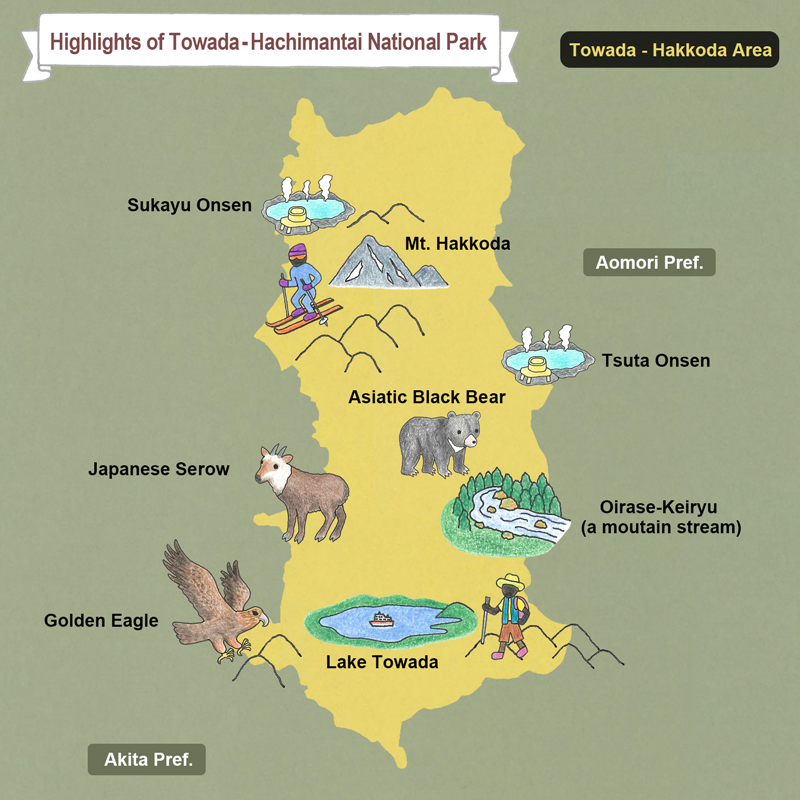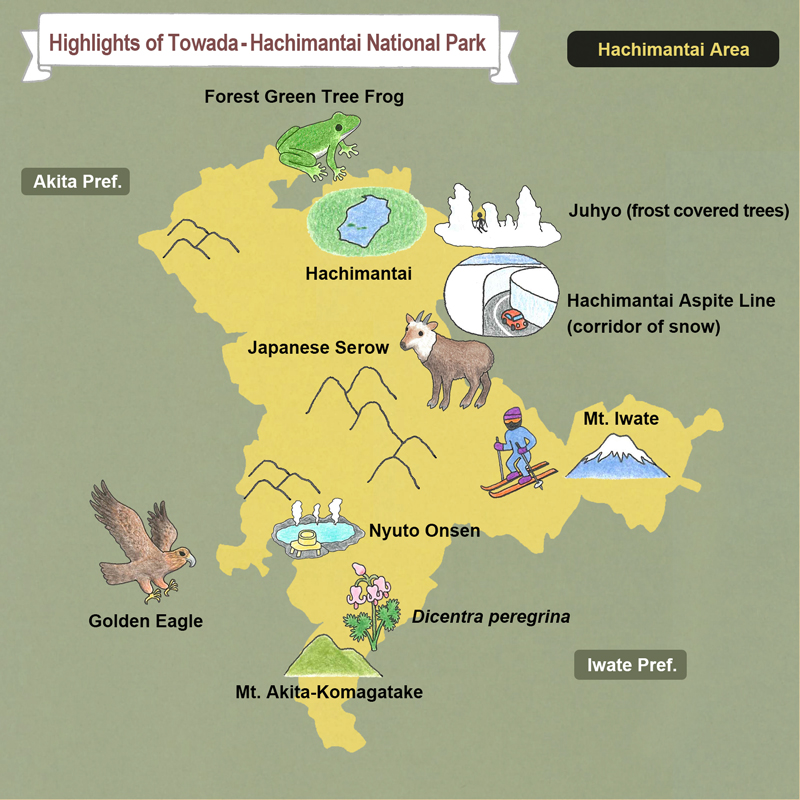- MOE
- National Parks of Japan
- Towada-Hachimantai National Park
- Guide of Highlights
main body
Highlights of Towada-Hachimantai National Park
Lake Towada Area
Mt. Hakkoda
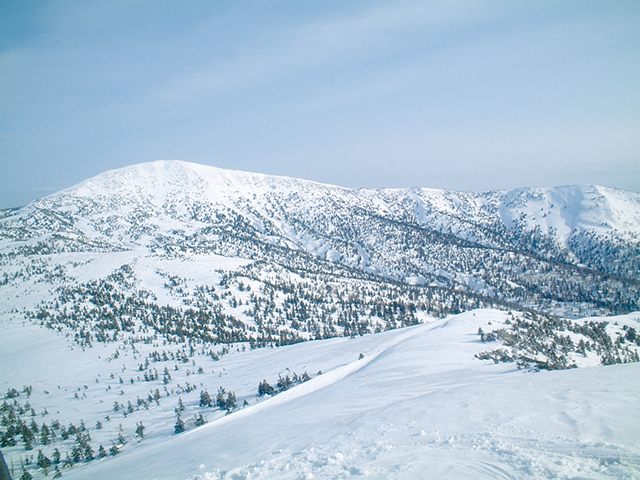
Mt. Hakkoda
Kita-Hakkoda Mountain Ranges have maintained trails and is loved by many hiking enthusiasts. However, the Minami-Hakkoda Mountain Ranges requires proper preparation and planning.
Oirase-Keiryu (a mountain stream)
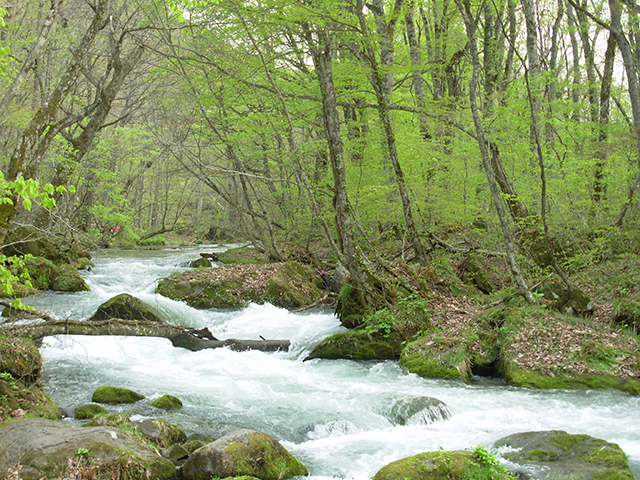
Oirase-Keiryu (a mountain stream)
The Oirase-Keiryu is a U-shaped valley approximately 14 km long that was carved out by the Oirase River, which is the only river that flows out of Lake Towada. Not only the clarity of the water flowing in the stream, but also the constantly changing flow, mossy rocks, forests of giant trees that cover the banks, and numerous waterfalls that flow over the rock face all come together to create one of the most scenic locations in Japan, and these are the reasons why Oirase Mountain Stream is designated as Japan's Special Place of Scenic Beauty and a Natural Monument. The spring and autumn foliage is particularly stunning, and the footpath maintained along the entire mountain stream is crowded with many tourists.
Lake Towada

Lake Towada
Lake Towada
Lake Towada is a caldera lake formed by volcanic activity that began approximately 200,000 years ago. The quiet lake surface and the rich greenery that covers the area from the lakeside to the somma create a primeval landscape and this place is designated as Japan's Special Place of Scenic Beauty and a Natural Monument. The mysterious view that changes with the seasons from a variety of perspectives such as the lakeside footpath and sightseeing boats on the lake, as well as the viewpoints on the somma, fascinates many visitors of the area. In addition to the Yasumiya-Yasumitai area at the base of the Nakayama Peninsula, there are many footpaths, sightseeing boat docks, and camping sites scattered around the lakeside that are crowded with many visitors.
Hachimantai Area
Mt. Hachimantai
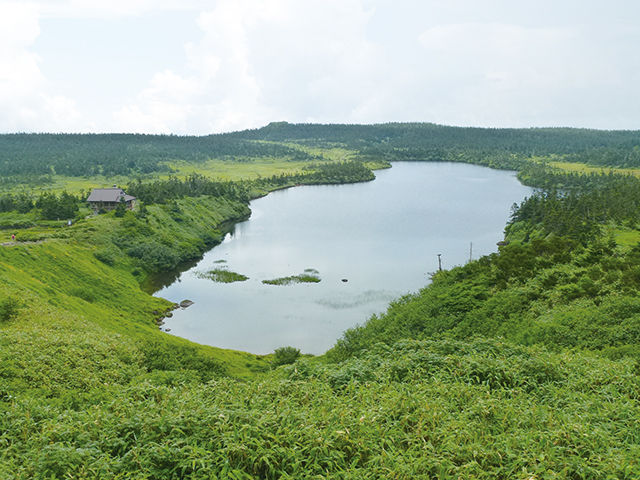
Mt. Hachimantai
In the area around the summit of Mt. Hachimantai, there is a highland marsh and the Hachiman Pond created when a crater formed from volcanic activities (steam explosions) were filled with water, and visitors can enjoy walks on the properly maintained footpaths.
Hachimantai Aspite Line (corridor of snow)
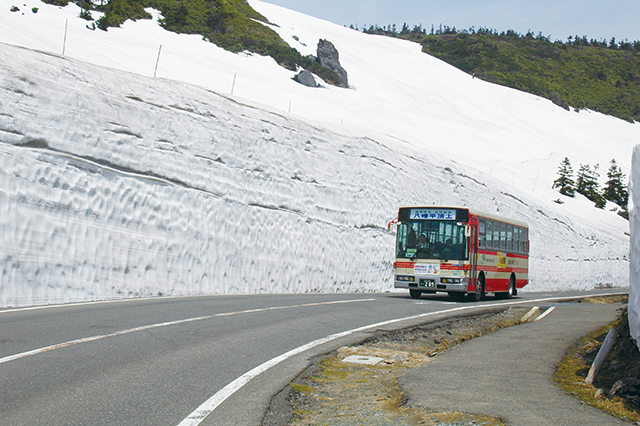
Hachimantai Aspite Line (corridor of snow)
A driveway extends 26.7 km across Hachimantai from the Hachimantai Gozaisho district in Iwate Prefecture to the Toroko Hot Springs in Akita Prefecture. A few meters of snow remains after reopening in mid April after the winter, producing the effect of a snow corridor.
Juhyo (frost covered trees)

Juhyo (frost covered trees)
Water vapours chilled to 5°C or below the freezing point, and super-cooled water droplets, are blown against the trees, forming ice. Covered in snow, it resembles a monster.
Mt. Yake-Yama (Akita-Yake-Yama)

Mt. Yake-Yama (Akita-Yake-Yama)
View the eruptions of the active volcanoes located in the west of Hachimantaira. View the crater walls and crater hot lake from Nagori Pass, and the striking volcanic topology of Onigajo and the like on the central volcanic cone.
Mt. Akita-Komagatake
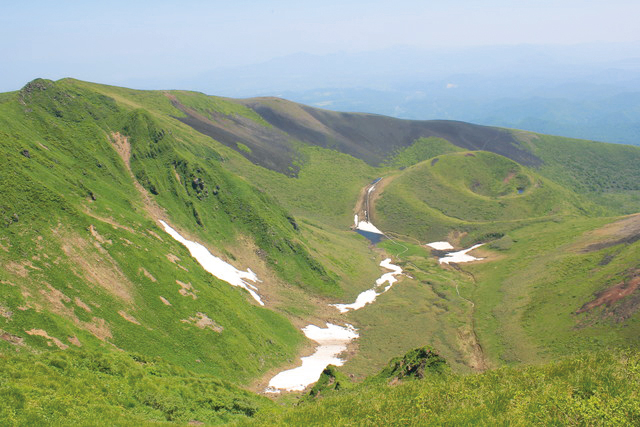
Mt. Akita-Komagatake
Boasting the highest peak (1,637 m above sea level) in Akita Prefecture, the Mt. Akita-Komagatake, along with Mt. Nyuto are famous mountains on the southern end of the Towada-Hachimantai National Park. Here you can enjoy fabulous views and abundance of alpine plants that are said to be the best in northern Japan.
Mt. Iwate
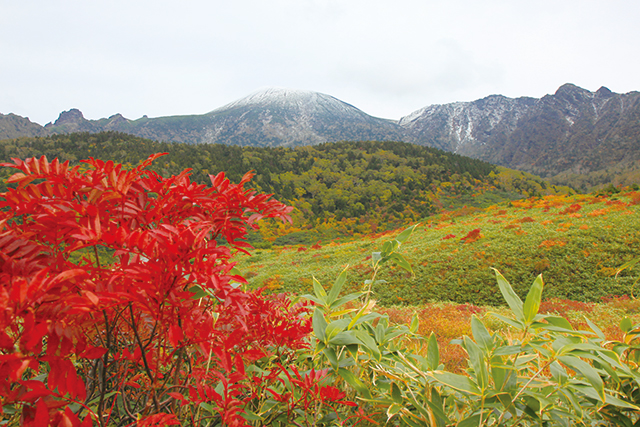
Mt. Iwate
Viewed from the east, this mountain has a beautiful shape and is known as Nambu-Kata Fuji, but on the west side expands a rugged, volcanic landscape.
Wildlife & Plants
Dicentra peregrina

Dicentra peregrina
Perennial plants blooming on the gravel areas of high mountains. When seen from a side view, the pink flower resembles the face of a horse when seen in side view. Therefore, in Japan it is called "komakusa" or "horse plant" and large clusters can be seen at the Akita Komagatake Oyakesuna and Iwatesan Yakehashiri routes.
Forest Green Tree Frog (Rhacophorus arboreus)

Forest Green Tree Frog (Rhacophorus arboreus)
A unique Japanese species, distributed throughout Honshu and Sado. Reproduction is on, rather than in, the water. Eggs are surrounded by clusters of bubbles attached to tree branches in the water. The frog can be seen in the area around Tsuta Onsen.
Golden Eagle (Aquila chrysaetos japonica)

Golden Eagle (Aquila chrysaetos japonica)
A large bird of prey found in mountainous regions from Hokkaido to Kyushu. The golden eagle is at the top of the ecological system in the plentiful natural environment. It has been identified in the Towada-Hachimantai National Park.
Japanese Serow (Capricornis crispus)

Japanese Serow (Capricornis crispus)
While they resemble a deer, they are of the cow family. Found in the forests of the park. Designated as a National Special Natural Monument.
Asiatic Black Bear (Ursus thibetanus japonicas)
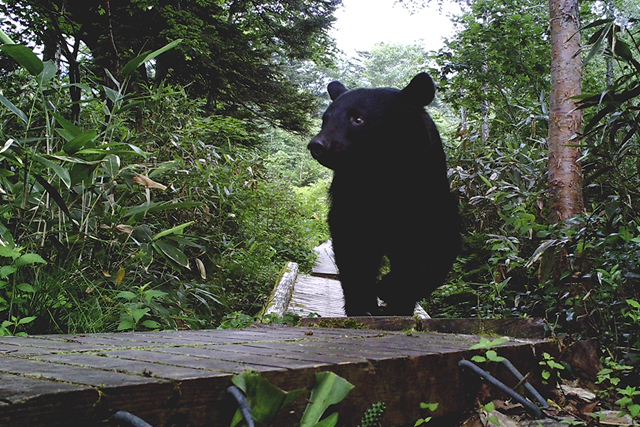
Photo by Hachimantai Branch, Natural Parks
Foundation
Foundation
Asiatic Black Bear (Ursus thibetanus japonicas)
The largest terrestrial mammal on Honshu. The bear is distinguished by the crescent/V-shaped white marking on the chest, so it is called "tsukinowaguma (moon-ring bear)" in Japanese. Found in the forests of the park. Understand the ecology, and avoid the bears.
Activities
Hot Springs (Onsen)

Tsuta Onsen
Hot Springs (Onsen)
This is a volcanic area, so there are also many good hot springs. Many of these hot springs have a history as a place for hot spring therapy, and each have retained a unique and quaint atmosphere. Additionally, many visitors use these hot springs as a base for mountain climbing and exploring the park, and they are popular attractions for all visitors of the park.

Nyuto Onsen
Camp
Camp
There are a variety of camping facilities available within the park where visitors can freely enjoy the rich natural surroundings.
Hiking and Walking
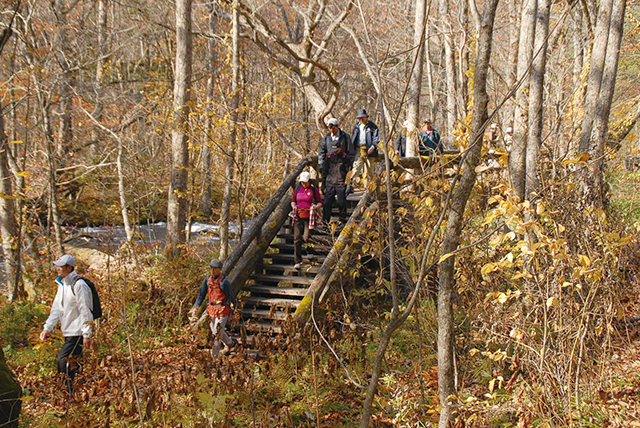
People Walking on the Trail
Hiking and Walking
The park has a walking trail where you can experience real nature in a one to several hours long walk that covers such scenic points as Oirase, Hachimantai and Mikaeri Pass, Hakkoda Ropeway, Tamoyachi, Sukayu, Jigokunuma, Tsutanuma, and Goshogake.
Skiing (Mt. Hakkoda)

Skiing (Mt. Hakkoda)
Mt. Hakkoda, at the northern end of the Ou Mountain Range turns into an expansive snow slope with heavy snow falls. Prefect for mountain skiing. Avoid skiing alone. A mountain guide is recommended.
Nature Observation Walk /Nature Experience Program
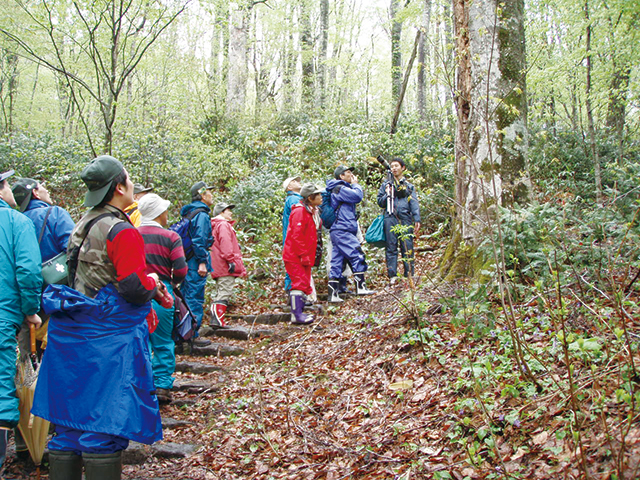
Nature Observation Walk
Nature Observation Walk /Nature Experience Program
At various regions in the Park, the visitor centers hold a variety of Nature Observation Walks and Nature Experience Programs depending on the unique characteristics of the region. For details, contact each facility.
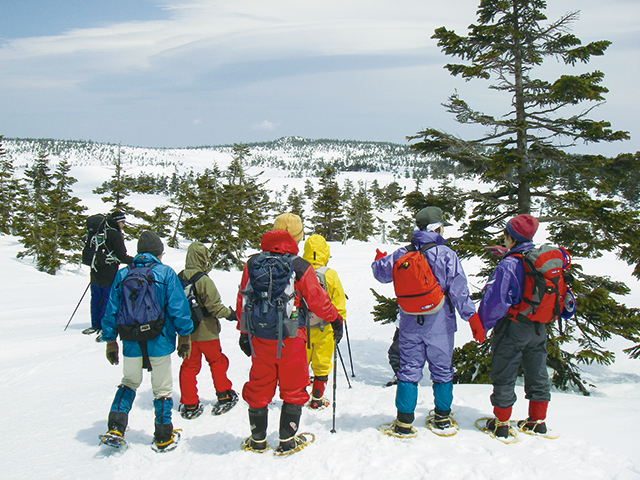
Snowshoe Hiking
Tourist Boats
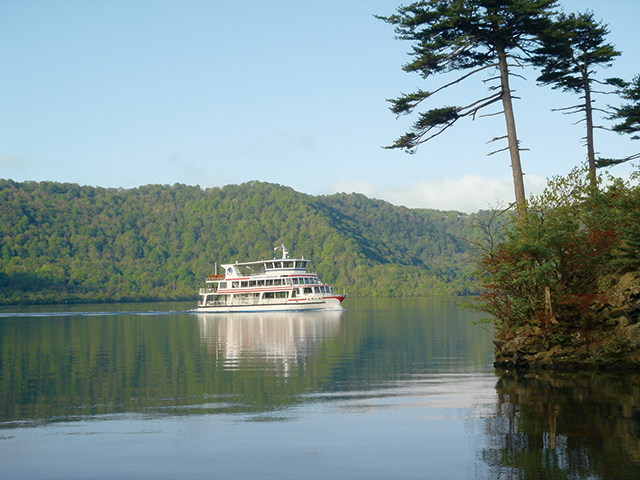
Sightseeing Boat Ttraveling around Lake Towada
Tourist Boats
Lake Towada is a mysterious, mountain-top caldera lake surrounded by lush green somma. Tourist boats that depart and arrive at the Yasumiya and Yasumitai area on the lakeside and the Nenokuchi area give visitors an opportunity to see the seasonal views that you can only see on the lake.
Hakkoda Ropeway
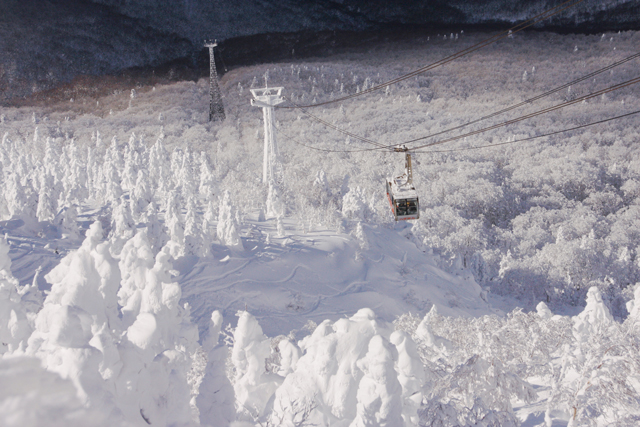
Hakkoda Ropeway
Mt. Hakkoda covers the chain of mountains from the northern Hakkoda range to the southern Hakkoda range. Use the Hakkoda ropeway to access the northern Hakkoda range. Walk from the Sancho-Koen-Eki Station on a pleasant stroll.
Driving and Observation Points

Driving and Observation Points
This park has numerous driving courses such as the route around Lake Towada, the route along the Oirase-Keiryu, the Hakkoda Towada Golden Line, the Hachimantai Aspite Line, and the Hachimantai Jukai Line. You can enjoy the different scenery of the changing seasons. On each course are popular viewpoints and scenic sites.
